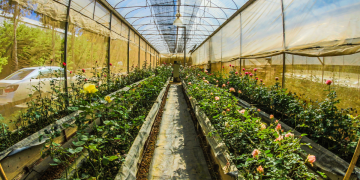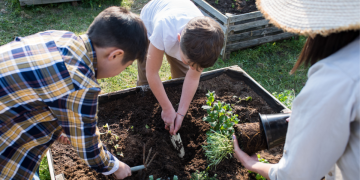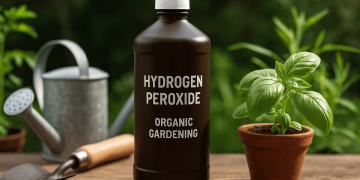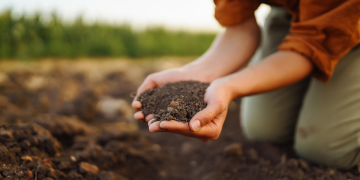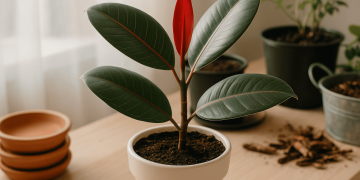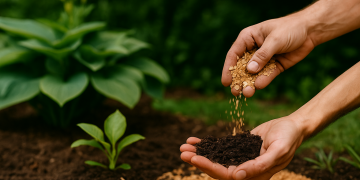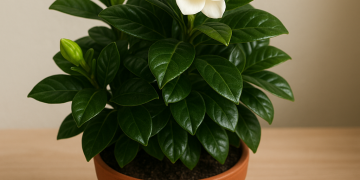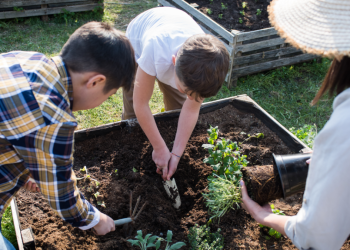Table of Contents
ToggleWhat Is Hydrogen Peroxide and Why Consider It for Organic Gardening?
Hydrogen peroxide, often simply referred to as H₂O₂, is a household staple most of us know from first aid kits and cleaning products. However, its use has made its way into gardening—especially organic gardening—in recent years, sparking both curiosity and debate. But what makes it show up on the radar of eco-conscious growers, and, more importantly, is hydrogen peroxide compatible with organic gardening principles?
For gardeners seeking alternatives to overly synthetic pesticides or aggressive disinfectants, hydrogen peroxide in organic gardening stands out mainly because of how it works. When diluted and applied carefully, it breaks down rapidly into water and oxygen—leaving behind no persistent chemical traces. This quick decomposition is part of its appeal, as it helps minimize long-term toxicity in the soil or on your plants. As an oxidizing agent, hydrogen peroxide can help address certain issues like fungus gnat infestations, soil-borne pathogens, or even oxygen-poor soils prone to root rot. Instead of introducing lingering chemicals, you’re leveraging a reaction that “cleans up” after itself.
Still, the question—is hydrogen peroxide safe to use?—is more nuanced than a simple yes or no. Not every organic gardener, nor every organic certification, looks kindly on hydrogen peroxide. Some stricter philosophies point out that, despite its clean breakdown, it remains a manufactured product, not a naturally occurring amendment or extract. Others, especially in practical home organic gardening, highlight its low residual impact and occasional effectiveness when used sparingly. The real answer? Hydrogen peroxide in gardening can align with eco-friendly values, but only when applied with restraint and for specific, justified reasons—not as a cure-all or routine input.
It’s important to move beyond myths. Just because hydrogen peroxide sounds “natural” doesn’t mean every use or concentration is safe for your plants. Questions like can hydrogen peroxide hurt plants? or how often should hydrogen peroxide be applied? require careful research—and precise ratios—rather than assumptions. It’s also a misconception to believe every use is permitted in organic gardening; you’ll want to double-check organic standards and, when in doubt, seek products that are certified for gardening use.
As you explore practical uses—such as the right hydrogen peroxide soil drench ratio or tips for hydrogen peroxide for gnats—the next section will guide you through responsible, effective, and safe application methods with your garden’s well-being in focus.
Practical Applications of Hydrogen Peroxide in the Garden: When, How, and Safety Considerations
Hydrogen peroxide has carved out a responsible role among organic gardeners seeking targeted, ecological solutions to specific plant health challenges. While it can be a powerful ally for root rot emergencies, seed germination, and even the control of certain pests like fungus gnats, its application must always be strategic, restrained, and informed by evidence—not folklore. The following guide clarifies exactly how to use hydrogen peroxide on plants, what ratios are safe, and when its use is compatible with the principles of ecological gardening.
Root Rot Rescue and Soil Aeration: Hydrogen Peroxide as a Soil Drench
When dealing with root rot, often caused by poor drainage and anaerobic soil conditions, hydrogen peroxide can offer a rapid, targeted response. By releasing extra oxygen into the soil, it both combats certain pathogenic fungi and temporarily boosts soil aeration. However, concentration and frequency are everything.
Recommended hydrogen peroxide soil drench ratio:
- Use 1 part of 3% hydrogen peroxide to 4 parts water for emergency root rot drench.
- Apply directly to the affected soil, never exceeding once every 6 weeks unless otherwise recommended by a horticultural expert.
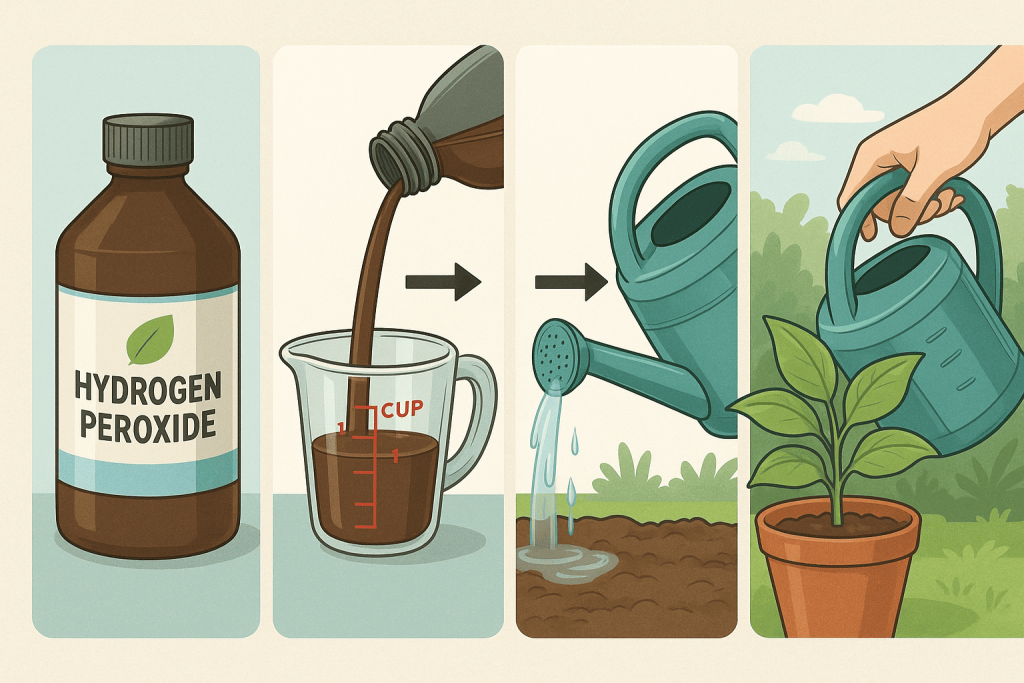
After treatment, always observe your plant for any signs of stress and discontinue use if leaf burn or wilting appears.
💡 Tip
Test the solution on a small section of soil first—plants and beneficial soil microbiota can be sensitive, and hydrogen peroxide should never be seen as an ongoing routine input.
Disinfection of Tools and Growing Media
Hydrogen peroxide excels at surface sterilization—not only of tools, but also seed trays and growing media reused between crops.
- Prepare a solution of 1 part hydrogen peroxide (3%) in 10 parts water.
- Dip or spray tools, let sit briefly, then rinse thoroughly with clean water.
Such disinfection reduces the spread of fungal or bacterial plant diseases, supporting the organic principle of prevention over cure.
Foliar Sprays: Limited Use for Surface Fungal Control
In cases of powdery mildew or superficial fungal diseases, a diluted foliar spray may be effective. For this, an accurate hydrogen peroxide foliar feeding ratio is crucial to avoid foliar burn.
Hydrogen peroxide foliar spray ratio:
- Mix 1 tablespoon of 3% hydrogen peroxide in 1 quart (about 1 liter) of water.
- Apply sparingly, targeting only affected leaves, and never more than once every 10-14 days.
Always apply during cooler parts of the day and test a small area before general application.
Stimulating Seed Germination
Some gardeners use hydrogen peroxide to break seed dormancy or sanitize seed coats, particularly with hard-to-germinate seeds. This is most appropriate with aged, slow-sprouting, or disease-prone seeds rather than routine sowings.
- Soak seeds in a very dilute solution (e.g., 1 teaspoon of 3% hydrogen peroxide per cup of water) for 10-30 minutes.
- Rinse seeds thoroughly in clean water before planting.
Used judiciously, this technique can promote healthier, faster sprouting in select scenarios.
Targeted Pest Control: Using Hydrogen Peroxide for Gnats
Fungus gnats thrive in overly moist soil and decaying organic matter. A carefully prepared soil drench can help reduce their numbers.
- Use the same 1:4 soil drench ratio (1 part 3% hydrogen peroxide to 4 parts water).
- Water the soil surface where gnats are present—avoiding direct contact with plant foliage.
- Limit application to once per pest cycle (about every 3-4 weeks), and address underlying issues of excessive soil moisture.
Safe Hydrogen Peroxide Uses in the Garden
| Application | Recommended Ratio | Frequency/Notes |
|---|---|---|
| Soil drench (root rot/gnats) | 1 part 3% H₂O₂ : 4 parts water | Once/6 weeks (root rot); 3-4 wks (gnats) |
| Foliar spray (fungi) | 1 tbsp 3% H₂O₂ : 1 qt water | Max. 1x per 10-14 days, spot-test first |
| Tool/growing media disinfection | 1 part 3% H₂O₂ : 10 parts water | As needed, always rinse after |
| Seed germination soak | 1 tsp 3% H₂O₂ : 1 cup water | 10-30 min soak, then rinse seeds |

⚠️ Warning
Excessive or improperly diluted hydrogen peroxide can damage plant roots, scorch leaves, and disrupt beneficial soil life. Always measure carefully, avoid repeated use, and never exceed recommended strengths.
Safety, Frequency, and Ecological Limits
A recurring question for responsible gardeners: Is hydrogen peroxide safe to use? The answer is a cautious yes—within strict boundaries. Overuse, high concentrations, or habitual application can diminish soil biodiversity, harm root hairs, and set back natural balances. If you find yourself wondering, can hydrogen peroxide hurt plants?—the risk is real if misapplied.
How often should hydrogen peroxide be applied? Only as a targeted, infrequent measure in clear problem scenarios. For routine plant care, compost teas and balanced irrigation are preferable for preserving organic gardening principles.
Is hydrogen peroxide compatible with organic gardening principles? Used sparingly and as a last resort, yes, as it’s quickly broken down into water and oxygen. However, reliance on it as a routine “cure-all” contradicts the ecological approach.
Hydrogen peroxide, wielded wisely, will earn its place among your essential gardening tools—but never as a shortcut or routine crutch. Equip yourself with precision kits, protective gloves, and a measured approach, and your garden ecosystem will thank you.
Final Tips and Natural Alternatives for Safer Organic Gardening
Understanding how to use hydrogen peroxide on plants can empower any gardener to respond efficiently to sudden issues like root rot or outbreaks of gnats. Still, it’s important to keep in mind: hydrogen peroxide is best used as a supportive, situational tool—not as the foundation of your organic gardening strategy. The real goal of a thriving, chemical-free garden lies in cultivating balance, resilience, and biodiversity through preventive measures.
A genuinely sustainable garden doesn’t rely on a single treatment, even those with relatively low toxicity. Integrating healthy soil practices, such as routine mulching, using rich compost, rotating crops, and encouraging a diverse microbial ecosystem, naturally fortifies plants and reduces reliance on interventions—chemical or otherwise. For those who wonder, “Is hydrogen peroxide safe to use?” or “Can hydrogen peroxide hurt plants?”—the answer depends on the dose, method, and frequency, as excessive or frequent applications can disrupt soil life or harm sensitive plant tissues. Always verify your hydrogen peroxide soil drench ratio and hydrogen peroxide foliar feeding ratio for each use case.
Natural Alternatives: Practical Paths to Plant Health
Beyond hydrogen peroxide, many natural alternatives support an organic approach aligned with ecological principles. Infusions of garlic or horsetail serve as gentle fungicides; biological controls like beneficial nematodes target gnats and other pests sustainably (for those specifically seeking “hydrogen peroxide for gnats” alternatives); physical traps or barriers, and fermented compost teas, can all form part of a wider, gentler management toolkit. These methods are not only compatible with organic gardening principles—they help create the conditions in which chemical interventions become the exception, not the rule.
To ensure your gardening practices remain safe and effective, always ask: “How often should hydrogen peroxide be applied?” The answer should be: only when essential, after preventive steps and natural methods have failed or if a problem escalates quickly. Frequent or habitual use can disrupt soil balance; instead, observe your garden closely, keep simple records of what you apply and its results, and adjust your approach season by season.
💡 Tip
Sustainable garden management is a balance—one that carefully considers safety, ecological harmony, and practical results. Hydrogen peroxide can be a helpful occasional resource, but it should never replace the foundational principles of organic gardening.
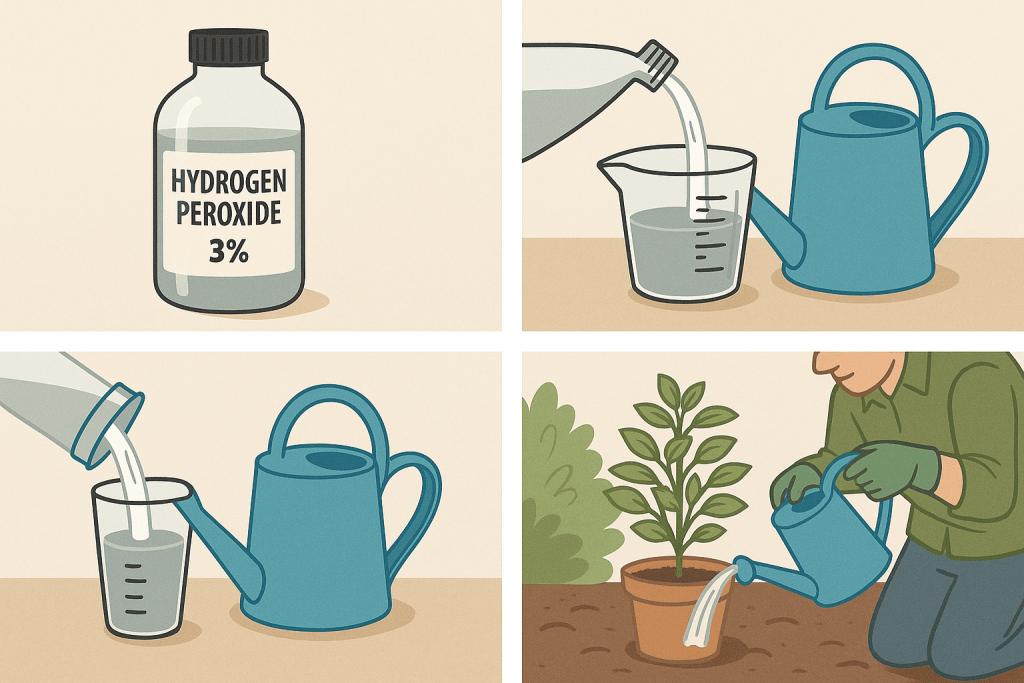
💡 Tip
“For those looking to deepen their knowledge or transform their gardening practices, consider starting with an organic gardening starter kit or enrolling in a specialised online course to build confidence and skill in ecological methods.”
By integrating informed, measured use of hydrogen peroxide—validated by experience and observation—with a commitment to organic best practices, you’ll nurture a garden that’s both healthy and truly sustainable. Keep learning, stay curious, and let nature lead your way.
References
- USDA eCFR — §205.601 Synthetic substances allowed for use in organic crop production — Hydrogen peroxide appears as an allowed input for algicide, disinfectant, and sanitizer purposes.
- HPNow’s Peroxide UltraPure™ now OMRI Listed — Official announcement of OMRI listing for plant disease control and sanitation.
- Organic Grower – “Peroxide UltraPure now OMRI listed” — Sector news confirming practical use in certified organic farms.
- Hortibiz Daily – “Ultrapure hydrogen peroxide available for organic use” — Industry news on the OMRI certification for horticultural hydrogen peroxide.

